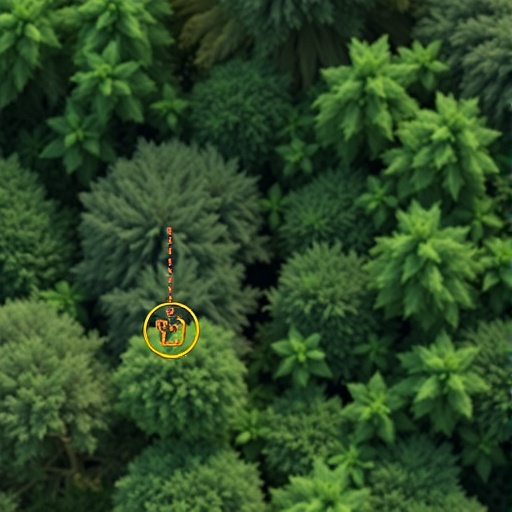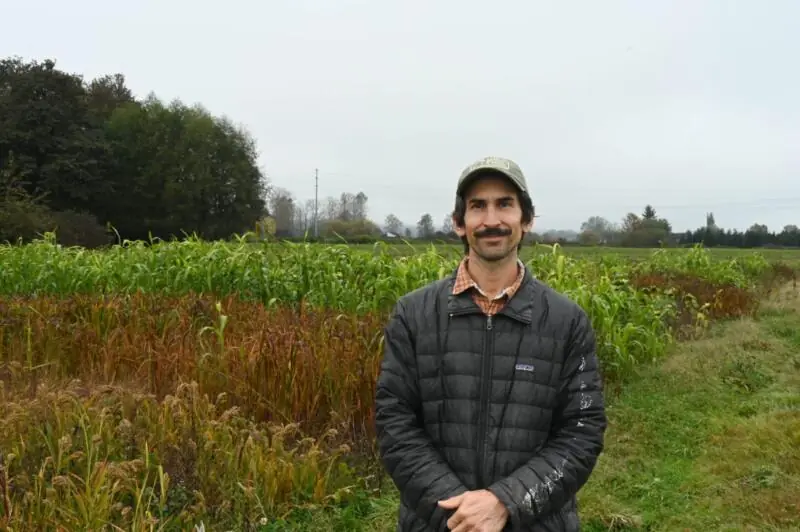Autonomous Drone Swarm Tracks Anomalies in Dense Vegetation – Bioengineer.org

Report on Autonomous Drone Swarm Technology for Environmental Monitoring
Executive Summary
A research team led by Amala Arokia Nathan has developed an autonomous drone swarm for detecting and tracking anomalies in dense vegetation. This technological advancement integrates swarm intelligence, artificial intelligence (AI), and advanced sensing to overcome the limitations of traditional monitoring methods. The system’s applications in agriculture, forestry, and conservation directly support the achievement of several United Nations Sustainable Development Goals (SDGs), particularly those related to environmental protection and food security.
Technological Framework and Core Innovations
The system’s effectiveness is rooted in a combination of sophisticated software and hardware components designed for complex natural environments.
- Swarm Intelligence: The operational logic is based on decentralized, collaborative algorithms inspired by natural phenomena like bird flocking. This allows the swarm to dynamically adapt its formation and coverage, enhancing detection efficiency and system resilience.
- Adaptive AI and Machine Learning: The AI framework incorporates continuous learning protocols. By processing real-time and historical data, the system refines its anomaly detection models to differentiate between natural environmental changes and critical threats such as disease or illegal deforestation.
- Advanced Sensor Suite: Each drone is equipped with multispectral cameras and LiDAR sensors. This hardware captures detailed visual and depth data, enabling the identification of subtle irregularities in vegetation that would otherwise be missed.
- Onboard Data Processing: Real-time data analysis is performed directly on the drones, reducing latency and dependence on remote communication links, which is critical for operations in remote areas.
Contribution to Sustainable Development Goals (SDGs)
The deployment of this autonomous drone swarm provides a powerful tool for advancing global sustainability targets. The technology’s impact is most significant in the following areas:
-
SDG 15: Life on Land
- Combating Deforestation: The swarm can autonomously patrol vast forested areas to detect and track illegal logging activities in near real-time, providing critical data for enforcement and conservation efforts.
- Protecting Biodiversity: By monitoring the health of vulnerable habitats and identifying the proliferation of invasive species, the technology supports the preservation of terrestrial ecosystems and biodiversity.
- Halting Land Degradation: The system generates detailed spatiotemporal maps of vegetation health, enabling land managers to implement targeted interventions to combat land degradation and promote ecosystem resilience.
-
SDG 2: Zero Hunger
- Sustainable Agriculture: The technology facilitates precision agriculture by identifying early signs of crop disease, pest infestations, or nutrient deficiencies.
- Enhancing Food Security: Early detection allows for timely and targeted interventions, preventing widespread crop loss and reducing the reliance on chemical treatments, thereby promoting sustainable food production systems.
-
SDG 13: Climate Action
- Enhanced Carbon Sequestration Monitoring: By providing continuous data on forest health and biomass, the technology aids in accurately assessing the role of forests as carbon sinks.
- Reduced Carbon Footprint: The autonomous swarm reduces the need for carbon-intensive monitoring methods such as manned aerial surveys and extensive ground patrols, aligning with goals for environmentally responsible practices.
-
SDG 9: Industry, Innovation, and Infrastructure
- Fostering Technological Innovation: This research represents a milestone in the integration of autonomous systems and ecological science, establishing a new paradigm for sustainable environmental management and fostering further interdisciplinary advancements.
Future Prospects and Conclusion
Future development plans aim to expand the swarm’s capabilities by integrating more advanced machine learning techniques and a broader array of sensors, including bioacoustic and chemical detectors. Such enhancements would broaden its application to monitoring animal populations and airborne pollutants.
In conclusion, the autonomous drone swarm technology is a transformative innovation with profound implications for environmental stewardship. Its ability to provide scalable, resilient, and accurate ecological assessments empowers global efforts to achieve conservation objectives and sustainable development, marking a significant step forward in protecting the planet’s natural ecosystems.
Analysis of Sustainable Development Goals in the Article
-
Which SDGs are addressed or connected to the issues highlighted in the article?
The article on the autonomous drone swarm for environmental monitoring connects to several Sustainable Development Goals (SDGs) by presenting a technological solution to pressing environmental and agricultural challenges. The primary SDGs addressed are:
- SDG 2: Zero Hunger: The technology’s application in agriculture to ensure food security is a key theme. The article states that in “large-scale farming operations, early identification of pest infestations or nutrient deficiencies can prevent widespread crop loss,” directly contributing to stable and sustainable food production.
- SDG 9: Industry, Innovation, and Infrastructure: The entire article is centered on a “groundbreaking technological advancement” that “integrates advanced robotics, artificial intelligence, and real-time data processing.” This highlights the role of innovation and scientific research in creating solutions for sustainable development, aligning with the goal of fostering innovation and building resilient infrastructure.
- SDG 13: Climate Action: The article explicitly mentions a climate co-benefit of the technology. It notes that by “reducing the need for manned aerial surveys and extensive ground patrols, the autonomous swarm decreases carbon footprints associated with traditional monitoring methods,” which directly supports climate change mitigation efforts.
- SDG 15: Life on Land: This is the most prominently featured SDG. The drone swarm is designed to manage and protect terrestrial ecosystems. The article details its use in monitoring “dense forests,” detecting “illegal deforestation activities,” assessing the “health of vulnerable species habitats,” safeguarding “biodiversity,” and identifying “invasive species proliferation.” These applications are central to the protection and sustainable use of forests and ecosystems.
-
What specific targets under those SDGs can be identified based on the article’s content?
Based on the specific applications and outcomes described in the article, the following SDG targets can be identified:
- Target 2.4: Under SDG 2, this target aims to “ensure sustainable food production systems and implement resilient agricultural practices.” The article supports this by describing how the drone swarm enables early detection of crop diseases and nutrient deficiencies, which helps “prevent widespread crop loss and reduce the need for chemical treatments,” thereby promoting more resilient and sustainable farming.
- Target 9.5: Under SDG 9, this target is to “Enhance scientific research, upgrade the technological capabilities of industrial sectors…encouraging innovation.” The article is a testament to this target, as it describes a “pioneering system, crafted by a multidisciplinary team” that represents a “monumental leap in environmental monitoring technologies” and a “milestone in the integration of autonomous systems with ecological science.”
- Target 13.3: Under SDG 13, this target focuses on improving “education, awareness-raising and human and institutional capacity on climate change mitigation.” The drone technology contributes by providing a tool that reduces the carbon footprint of monitoring activities, thus representing an advancement in institutional capacity for environmentally responsible practices.
- Target 15.2: Under SDG 15, this target aims to “promote the implementation of sustainable management of all types of forests, halt deforestation.” The article directly addresses this by stating the technology can monitor for “illegal logging” and “illegal deforestation activities,” providing a crucial tool for forest management and conservation.
- Target 15.5: Under SDG 15, this target is to “take urgent and significant action to…halt the loss of biodiversity.” The drone swarm contributes by “assessing the health of vulnerable species habitats” and “safeguarding biodiversity,” enabling timely interventions to protect ecosystems.
- Target 15.8: Under SDG 15, this target aims to “prevent the introduction and significantly reduce the impact of invasive alien species.” The article mentions that the system’s anomaly detection models can identify “invasive species proliferation,” allowing land managers to take action before significant damage occurs.
-
Are there any indicators mentioned or implied in the article that can be used to measure progress towards the identified targets?
The article implies several indicators that can be used to measure progress towards the identified targets, primarily through the data the drone swarm collects and the outcomes of its deployment.
- For Target 2.4 (Sustainable Agriculture):
- Implied Indicator: Rate of early detection of crop stress (pests, disease, nutrient deficiency). The article highlights the system’s ability for “early identification of pest infestations or nutrient deficiencies.”
- Implied Indicator: Reduction in crop loss percentages. This is a direct outcome of the technology’s ability to “prevent widespread crop loss.”
- Implied Indicator: Volume of chemical treatments (pesticides, fertilizers) avoided due to targeted intervention. The article states the technology can “reduce the need for chemical treatments.”
- For Target 9.5 (Research and Innovation):
- Mentioned Indicator: Number of scientific and technical publications. The article itself, “published in 2025 in Communications Engineering,” serves as a direct indicator of research output.
- For Target 13.3 (Climate Action):
- Mentioned Indicator: Reduction in carbon emissions from monitoring activities. The article explicitly states the technology “decreases carbon footprints associated with traditional monitoring methods.”
- For Targets 15.2, 15.5, and 15.8 (Life on Land):
- Implied Indicator: Area of forest monitored for illegal deforestation. The technology is designed for “dense forests and agricultural expanses.”
- Implied Indicator: Number of detected incidents of illegal logging or invasive species proliferation. The system is built to identify “critical irregularities that could indicate…invasive species proliferation, or illegal deforestation activities.”
- Implied Indicator: Spatiotemporal maps of vegetation health and biodiversity habitats. The article mentions the swarm’s ability to generate “spatiotemporal maps that detail the development of aberrations within the vegetation cover.”
- For Target 2.4 (Sustainable Agriculture):
-
Create a table with three columns titled ‘SDGs, Targets and Indicators” to present the findings from analyzing the article. In this table, list the Sustainable Development Goals (SDGs), their corresponding targets, and the specific indicators identified in the article.
SDGs Targets Indicators SDG 2: Zero Hunger Target 2.4: Ensure sustainable food production systems and implement resilient agricultural practices. - Rate of early detection of pest infestations and nutrient deficiencies in crops.
- Reduction in crop loss due to timely intervention.
- Reduced volume of chemical treatments used in agriculture.
SDG 9: Industry, Innovation, and Infrastructure Target 9.5: Enhance scientific research and upgrade technological capabilities. - Number of scientific publications on new environmental technologies (as evidenced by the article itself).
- Deployment of advanced autonomous systems for ecological research.
SDG 13: Climate Action Target 13.3: Improve capacity on climate change mitigation and early warning. - Reduction in carbon footprints from environmental monitoring activities compared to traditional methods.
SDG 15: Life on Land Target 15.2: Promote sustainable management of forests and halt deforestation. - Number of detected incidents of illegal logging and deforestation.
- Area of forest under continuous autonomous surveillance.
Target 15.5: Halt the loss of biodiversity. - Generation of spatiotemporal maps assessing the health of vulnerable species habitats.
- Timely detection of threats to biodiversity within monitored ecosystems.
Target 15.8: Prevent and reduce the impact of invasive alien species. - Rate of detection of invasive species proliferation in monitored areas.
Source: bioengineer.org
What is Your Reaction?
 Like
0
Like
0
 Dislike
0
Dislike
0
 Love
0
Love
0
 Funny
0
Funny
0
 Angry
0
Angry
0
 Sad
0
Sad
0
 Wow
0
Wow
0



















































.jpg.webp?itok=0ZsAnae9#)























